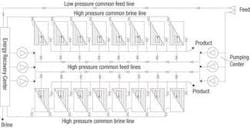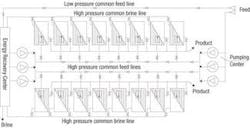Centralised design achieves low-cost desalinated water
By Lance Johnson & Dr. Boris Liberman
The OTID Consortium identified and incorporated several key features into the 100 million m3-dealination plant under construction in Ashkelon, Israel, that optimises the process to produce potable water annually at the lowest cost ever achieved without sacrificing performance reliability.
The French company OTV and IDE Technologies Ltd., based in Israel, worked together in the OTID Consortium to improve the reverse osmosis (RO) seawater desalination process design, making it more economical. The Ashkelon plant includes a "three-centre" design, a cascading four-stage RO system, a "permeate split" design and high pH operation.
Desalination plants are typically designed to operate with several identical RO trains, each featuring its own high-pressure pump, energy recovery device and bank of membranes. More identical RO trains are added to meet the greater need should greater capacity become necessary.
This design philosophy works well for a standard-sized plant, but beyond a certain point it becomes uneconomical. The continued enlargement of a typically designed plant ultimately results in a contradiction between the optimal sizes of pumps, membrane banks and energy recovery devices, de-optimising scale-up potential in large RO trains.
A new centralised design was necessary to achieve continuous operation, consistent product quality and low costs. Plant designers solved the problem by separating high-pressure pumps from energy recovery devices. This move transformed the standard, decentralised RO train design into a unique, novel design featuring three centralised and independent centres: a Pumping Centre, an RO Membrane Banks Centre and an Energy Recovery Centre (see Figure 1).
The Pumping Centre was designed to take advantage of larger pumps' higher efficiency at lower specific costs. Under a typical design, these efficiencies could not be realised by adding pumps in proportion to the number of trains. The three-centre design allows for pump designs based on the optimal efficiency of the pumps, without having them tied to any particular train size.
The Membrane Banks Centre of the three-centre design likewise allows for independent optimisation of RO bank size, enabling designers to take into account maintenance, flushing, and cleaning, as well as the overall practicality of size.
The Energy Recovery Centre allows the pumping of larger quantities of seawater without significant pressure waves. The control of flow circulating in the brine loop is independent of flow in the Pumping Centre, which allows a wide range of recovery and an increase in system efficiency. The centralized design eliminates the sub-optimisation found in decentralised systems due to cleaning and maintenance when energy recovery devices are taken off line.
A key challenge of the Ashkelon project was to achieve final product water that contained a very low level of boron because high concentrations of boron can pose possible health hazards to humans and affect plants and crops negatively. The design of a cascading four-stage RO desalination system combined with permeate split to allow for high recovery and high boron removal solves this issue. This system results in low specific power and chemical consumption, and low capital investment.
The first stage of the system consists of a conventional seawater RO desalination stage. The permeate is split into two parts, lead and tail, and the lead part is collected from the feed side of the pressure vessel. The lead permeate has a lower concentration of boron than the whole permeate and is used to obtain the final product water by being mixed with the product water from stages two and four. The tail permeate is fed to a second RO stage, which is smaller in size due to the permeate split, resulting in lower capital and operating expenses.
The second RO stage operates at a high pH and treats the tail permeate from the first stage. The permeate from the second stage has a low concentration of boron and constitutes a product water. The brine discharged from this stage has 700 to 1000 ppm of Na ions, 10 to 15 ppm of Ca and 45 to 60 ppm of Mg when operating with an 85% recovery. (This proportion of Ca to Na ions is normal for the softening of the third RO stage, but would not be economical for softening with ion exchangers.)
The softening in the third stage recovers the second stage brine under neutral pH. The reason for the neutral pH is so that calcium carbonate and magnesium hydroxide salts cannot form scaling on membrane surfaces when operated at high recovery and high brine concentration.
The neutral pH of the third stage also means low boron rejection; therefore, the permeate from this stage must be treated in the fourth and final RO stage at high pH and high recovery.
The need for high boron rejection necessitated a design specifying operation at high pH (up to 10.8) because pH is one of the strongest factors influencing boron rejection. Research has shown that rejections are significantly improved at higher pH values, owing to a shift from boric acid to the better-rejected species of borate ions.
The unique nature of the Ashkelon project's design challenges required RO technology that met a number of specific, stringent requirements. Membranes that demonstrated high, stable salt and boron rejection levels under high pH operation with high recovery – all at a lower operating cost – were needed to make the design a reality. For these reasons, design engineers specified Filmtec™ RO mem-brane elements, manufactured by the US-based Dow Chemical Company, to meet project goals.
Membrane type and operational conditions have a strong influence on the boron rejection of a seawater RO system. At the natural pH level of most waters used in desalination (pH 7 to 8), the predominant species of boron is boric acid in molecular form. At these pH values, the percentage of the non-dissociated boron species B(OH)3 is between 99.3% (pH 7) and 93.2% (pH 8) of total boron. The rejection of that species of boron is in the range of 82% to 92% for most seawater RO membrane products on the market and the rejection for brackish water products ranges between 30% and 80%.
Project designers had to select a seawater membrane that enabled the highest boron rejection in the first stage of the RO process to reduce dependency on subsequent stages and achieve a higher permeate split. For the brackish water stages, high pH operation is important because brackish water membranes in subsequent stages have lower rejection under neutral pH. Operation at a pH above 10 causes the boron species to exist more as borate, enabling better rejection by the brackish water membranes.
Figure 3 shows the typical boron rejections under standard test conditions for the membranes chosen for use in the project.
The rejection for brackish water membranes is lower than seawater membranes at neutral pH, but rejection for all membranes becomes quite similar at higher pH. Consequently, operating at high pH is important for brackish water membranes, and long-term membrane stability at high pH is equally important.
Scaling can be controlled with today's anti-scalants, and most scales (carbonates, hydroxides, sulphides) can be removed by relatively mild pH. High pH cleaning conditions effectively remove most foulants.
The membranes chosen for use in the project have demonstrated robustness and stability under high pH operation because they are free of oxidative post-treatments. This fact also enables a wider pH range for cleaning purposes, and was an important membrane selection criterion.
Conclusion
Once operations begin in 2005, the Ashkelon facility will help ensure that potable water needs for this extremely dry Middle Eastern region are economically met well into the future. Large-scale desalination projects, such as this plant, are likely to be the wave of the future around the world for two reasons. First, the vast amount of ocean water available for desalination ensures a sustainable supply. Second, desalination costs are becoming more affordable due to the use of novel and innovative system designs, and advanced RO membrane technology. Further opportunities for optimised RO system performance are certain to be discovered, ensuring that sustain-able water-supply demands and challenges of tomorrow will be met.
Authors' NoteLance Johnson is the large-project market manager for The Dow Chemical Company, based in Midland, Michigan. Dr. Boris Liberman is the head of RO desalination department at IDE Technologies, based in Israel.



